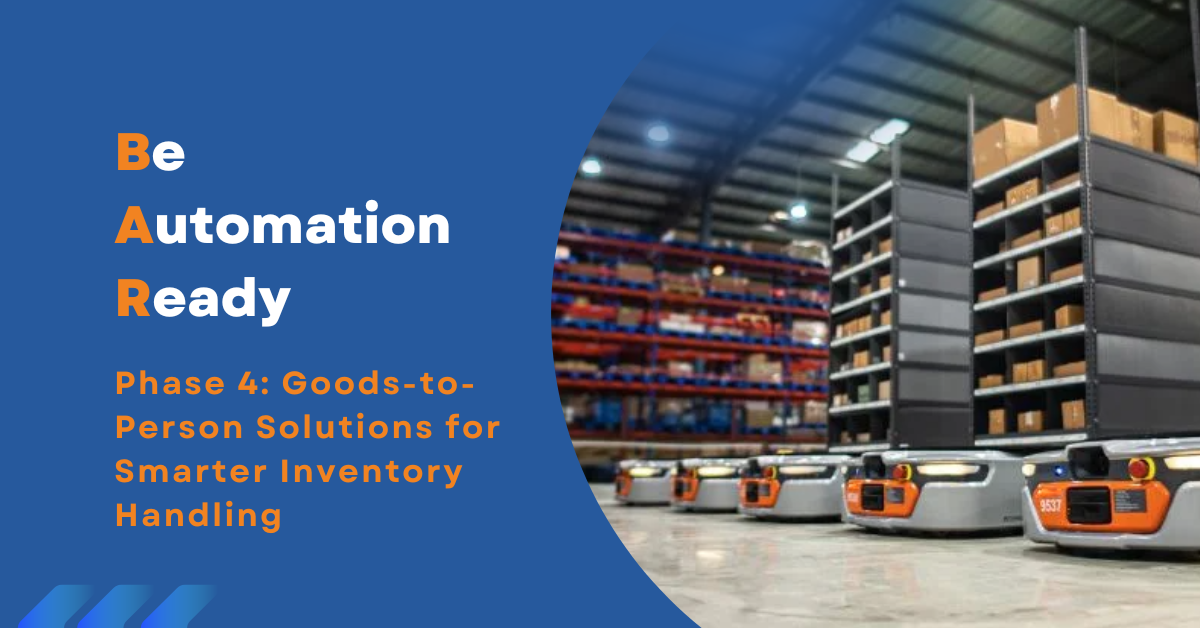


Welcome back to the BAR (Be Automation Ready) series! Following Phase 3: Assisted Picking, we now turn our attention to Phase 4: Goods-to-Person (GTP) Automation. This phase explores the automation of inventory delivery directly to workers, significantly boosting throughput and driving efficiency.
Recent industry surveys show that nearly 60% of companies now utilize some form of warehouse robotics and 92% are planning to invest in robotics over the next two years, signaling continued growth and adoption across the supply chain sector.
GTP automation leverages robotic systems to transport inventory from storage areas to workstations, minimizing the need for workers to travel through the warehouse. This process reduces inefficiencies and can increase throughput by 2-4x. By delivering goods directly to workers, GTP systems enhance accuracy and safety. They minimize the need for workers to walk between locations, streamlining operations and improving workflow.
Integrating Warehouse Execution Systems (WES) into GTP automation is key. WES orchestrates the flow of goods across multiple systems — whether it’s automated storage and retrieval systems (AS/RS), robotic transport systems or manual workflows. By seamlessly connecting these components, WES optimizes task prioritization, routing and resource allocation, ensuring that each order is fulfilled with maximum efficiency.
GTP automation offers a strategic advantage by streamlining operations, enhancing accuracy, maximizing space and improving worker safety — all critical factors in warehouse efficiency.
GTP systems drastically reduce the time workers spend walking between storage locations, enabling them to focus solely on order fulfillment. This results in faster processing times and higher throughput.
By delivering the correct items directly to the workstation, GTP systems minimize human error. Integrated verification technologies, such as barcode scanning or RFID, further ensure order accuracy.
GTP solutions make better use of vertical space, allowing storage systems to extend upwards. As a result, companies can increase storage capacity without the need for expanded square footage or additional floor space.
Workers no longer need to perform physically demanding tasks like walking long distances or reaching for high shelves. GTP systems bring items to an ergonomic height, improving workplace safety and reducing worker injuries.
The components of a GTP system work together to create an efficient warehouse ecosystem where inventory comes directly to workers rather than requiring workers to travel throughout the facility.
These systems manage the storage and retrieval of goods within the warehouse. Examples include shuttle systems, vertical lift modules (VLMs) and robotic arms.
Mobile robots or conveyors transport items from storage areas to designated workstations or Pick Put Stations (PPS), drastically cutting down the time workers spend moving between storage locations.
At ergonomically designed stations, workers receive, process and pack items delivered by the GTP system.
Implementing GTP automation requires a strategic approach with five critical steps that can streamline warehouse operations while delivering a substantial return on investment (ROI).
Identify areas where GTP automation can deliver the most value. Consider factors such as order volume, warehouse layout and existing inefficiencies. Integrating a WES is critical in this step, as it helps identify where the orchestration of multiple systems will bring the greatest ROI.
Select a GTP system that aligns with your operational goals. Evaluate options based on scalability, integration capabilities and ROI.
Design a layout that optimizes the flow of goods and minimizes bottlenecks. Consider how GTP systems will integrate with existing processes and technologies.
Ensure workers understand how to operate and collaborate with GTP systems. Training should focus on workstation processes, system interfaces, troubleshooting and how to interact with WES for optimal performance.
Track performance metrics, such as order processing time and accuracy rates. Use this data to fine-tune the system and maximize its benefits.
Phase 4: Goods-to-Person (GTP) Automation represents a significant milestone in the BAR journey. By streamlining inventory handling and boosting efficiency, GTP systems pave the way for even more advanced automation phases, such as waveless fulfillment and end-to-end robotic workflows. Companies that implement GTP systems typically realize ROI within two years, making it a cornerstone of modern warehouse strategy.
In our next guide, we’ll explore Phase 5: Waveless Fulfillment. Discover how continuous, real-time order processing can eliminate batching inefficiencies and further enhance warehouse productivity.
Contact GreyOrange today to learn how GTP automation and warehouse orchestration can help you achieve your operational goals.